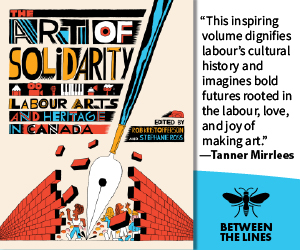The meaning of Hillsborough
Marking the 33rd anniversary of the worst disaster in British sporting history

Liverpool fans hold up banners commemorating those who lost their lives in the 1989 Hillsborough disaster. Photo by Andrew Cowie/AFP.
The following article originally appeared in the January/February 2013 edition of Canadian Dimension to commemorate the Hillsborough disaster, a fatal human crush that killed 97 Liverpool fans during an FA Cup semi-final match at Hillsborough Stadium in Sheffield, South Yorkshire, England, on April 15, 1989. It remains the worst disaster in British sporting history. Following a 27-year campaign by the victims’ families, an inquest ruling in 2016 found that the fans were unlawfully killed—despite having been initially blamed for the crowding which was principally caused by police errors and stadium defects. As Simon Black writes, the disaster revealed the class injustice at the heart of Margaret Thatcher’s Britain; the police-orchestrated cover-up reflected contempt for working people, and particularly the working class of Liverpool, which characterized Thatcher’s rule. It is republished here on the 33rd anniversary of the tragedy.
On April 15, 1989, Liverpool Football Club and Nottingham Forest met at Hillsborough Stadium, Sheffield, in the semi-final of English soccer’s oldest and most prestigious competition, the FA Cup. With only minutes played, police stopped the match. At one end of the stadium, in the lower tier of a stand allocated to Liverpool’s traveling support, fans were climbing the security fences which penned them in. Others were being lifted to safety by those seated in the stand above. Attempting to ease crowd pressure outside the stadium, police had ordered open a large exit gate; bodies surged into the stand’s lower-tier. 96 fans died in the crush; hundreds more were injured.
In the days following, higher-ups in the South Yorkshire Police engaged in a secret campaign of misinformation and victim-blaming that has taken twenty-three years to uncover. Many fans knew the truth—that the police were criminally negligent—yet their voices were ignored by the powers that be. Ignored because they were working class people from Liverpool, and because they were football fans. Only ‘trade unionist’ and ‘young black male’ were more despised identities among the ruling elite of Thatcher’s Britain.
Feeding stories of fan drunkenness and aggression to the conservative press, South Yorkshire Police produced a history in which they were exonerated from any wrongdoing. Newspaper headlines read ‘Dead fans robbed by drunk fans,’ Liverpool fans ‘were drunk and violent and their actions were vile.’ Rupert Murdoch’s The Sun ran the headline ‘The Truth’ claiming fans had urinated on police officers resuscitating the dying. Thousands of Liverpool fans arrived ticketless at the stadium, The Sun claimed, so they were ultimately responsible for the tragedy. The deceased were at fault for their own deaths.
This September, after 23 years of Liverpool fans campaigning for the real truth, an independent Hillsborough investigative panel released its final report. The panel found that 116 of the 164 police statements taken in the wake of Hillsborough were doctored to show the South Yorkshire force in a better light. Broken turnstiles, unheeded safety concerns, but most importantly, police mistakes had led to the dangerous overcrowding and the deaths of the 96. The panel’s most tragic finding was that 41 of the victims may have been saved had the police’s response been competent.
The police-orchestrated cover-up reflected the contempt for working class people, and particularly the working class of Liverpool, which characterized Thatcher’s rule. Liverpool was a city in revolt against Thatcherism, refusing to quietly accept the neoliberal doctrine of ‘free markets and disciplined people.’
Monetarist policies designed to punish the industrial working class had led to high unemployment rates across Britain’s industrial north, but nowhere was harder hit than Liverpool, with unemployment bordering on 50 percent in some inner-city neighbourhoods. The Liverpool riots of 1981, two years after Thatcher’s election, saw unemployed youth fight street battles with the city’s police.
Thatcher’s advisors said there was “a concentration of hopelessness” in Liverpool, the result of a declining economy caused by industrial strife. In other words, the city’s working class was too unruly, driving capital elsewhere. Responding to calls for investment in the city, one of Thatcher’s cabinet ministers said “Isn’t this pumping water uphill? Should we go rather for ‘managed decline’?”
Following the riots, with their collective middle-finger up at Thatcher, the people of Liverpool elected a socialist city council, run by a radical left faction of the Labour Party. To borrow the title of a history of the period, Liverpool was A City That Dared to Fight.
Given this context, it is a shame that the independent investigation was unable to determine was how high up the police ranks the Hillsborough cover-up went—classified cabinet documents on the matter will be released in 2019. By the time of the disaster, the South Yorkshire Police had formed a close relationship with the domestic intelligence service, the MI5, collaborating to crush workers in the 1984-85 miners’ strike. If the miners were the ‘enemy within,’ as Thatcher branded them, then the city of Liverpool was ‘enemy territory.’
We know now of the collusion between Thatcher, the secret services, the police and the tabloids to defeat the miners. What we are yet to find out is how far the Conservative government went to humiliate, vilify and defame the rebel city of Liverpool.
Simon Black is an Assistant Professor of Labour Studies at Brock University and Canadian Dimension’s sports columnist.










